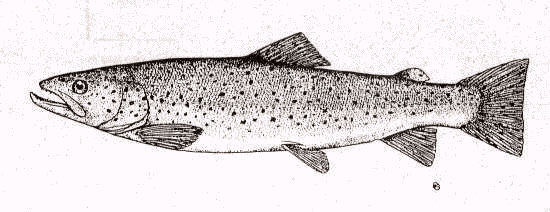
| RESEARCH BRIEFS |

|
Investigators: S.W. Wolff and T.A. Wesche, Wyoming Water Research Center, and D.D. Harris and W.A. Hubert, USDI, FWS/University of Wyoming Cooperative Fish and Wildlife Research Unit.
Purpose: Most research on minimum flows focuses on development of instream flow and habitat models but minimal reported evidence links biological response of fish populations to changes in minimum flows. This study assessed the biological significance of an increase in minimum flow to the brown trout (Salmo trutta) population in Douglas Creek, Wyoming.

Results: A four- to six-fold increase in brown trout standing stock was indicated between 1972 and 1988-89 in the 6.4 miles reach immediately downstream from the point of water diversion. Within this reach, the minimum low flow was 5.5 times greater than in the 1970s; habitat for adult fish was almost five times greater.
More than a twofold increase in brown trout standing stock between 1973 and 1988-89 was measured in a one mile reach between Rob Roy Dam and the point of water diversion. Within this reach, discharge was occasionally as low as 3.0 cfs before 1986, but not as severe as the 1.0 cfs downstream from the water diversion.
At sites more than 6.4 miles downstream from the water diversion structure, where the effect of reduced flow had been less because of the addition of water from tributary streams, there were no measurable changes related to the enhanced minimum flow.
Though additional work is necessary, this study supports the long-term value of increased minimum flow to fish populations.
Publication:
Brown trout population and habitat changes associated with increased minimum low flows in Douglas Creek, Wyoming. US Department of Interior Fish and Wildlife Service, Biological Report 90(11).
WWRC RESEARCH BRIEFS are published by the Wyoming Water Research Center with funds provided in part by the US Geological Survey, Department of Interior, as authorized by the Water Resources Research Act of 1984. The research on which this report is based was financed in part by the US Fish and Wildlife Service, Department of Interior, and the Wyoming Water Research Center. The views expressed do not necessarily represent those of the Department of Interior or the WWRC. Persons seeking admission, employment, or access to programs at the University of Wyoming shall be considered without regard to race, color, national origin, sex, age, religion, political belief, handicap, or veteran status.
 |
RB91-02 |
Research Briefs List
Water Resources Data System Library |
Water Resources Data System Homepage